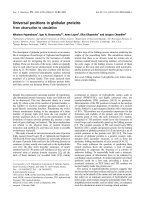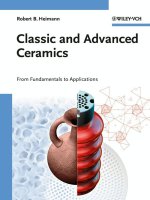- Trang chủ >>
- Khoa Học Tự Nhiên >>
- Vật lý
biomimetic nanoceramics in clinical use. from materials to applications,
Bạn đang xem bản rút gọn của tài liệu. Xem và tải ngay bản đầy đủ của tài liệu tại đây (2.46 MB, 185 trang )
Biomimetic Nanoceramics in Clinical Use
From Materials to Applications
RSC Nanoscience & Nanotechnology
Series Editors
Professor Paul O’Brien, University of Manchester, UK
Professor Sir Harry Kroto FRS, University of Sussex, UK
Professor Harold Craighead, Cornell University, USA
This series will cover the wide ranging areas of Nanoscience and Nanotechnology. In
particular, the series will provide a comprehensive source of information on research
associated with nanostructured materials and miniaturised lab on a chip technologies.
Topics covered will include the characterisation, performance and properties of ma-
terials and technologies associated with miniaturised lab on a chip systems. The books
will also focus on potential applications and future developments of the materials and
devices discussed.
Ideal as an accessible reference and guide to investigations at the interface of chemistry
with subjects such as materials science, engineering, biology, physics and electronics for
professionals and researchers in academia and industry.
Titles in the Series:
Atom Resolved Surface Reactions: Nanocatalysis
PR Davies and MW Roberts, School of Chemistry, Cardiff University, Cardiff, UK
Biomimetic Nanoceramics in Clinical Use: From Materials to Applications
Marı
´
a Vallet-Regı
´
and Daniel Arcos, Department of Inorganic and Bioinorganic Chem-
istry, Complutense University of Madrid, Madrid, Spain
Nanocharacterisation
Edited by AI Kirkland and JL Hutchison, Department of Materials, Oxford University,
Oxford, UK
Nanotubes and Nanowires
CNR Rao FRS and A Govindaraj, Jawaharlal Nehru Centre for Advanced Scientific
Research, Bangalore, India
Visit our website at www.rsc.org/nanoscience
For further information please contact:
Sales and Customer Care, Royal Society of Chemistry, Thomas Graham House,
Science Park, Milton Road, Cambridge, CB4 0WF, UK
Telephone: +44 (0)1223 432360, Fax: +44 (0)1223 426017, Email: s a
Biomimetic Nanoceramics
in Clinical Use
From Materials to Applications
Marı
´
a Vallet-Regı
´
and Daniel Arcos
Department of Inorganic and Bioinorganic Chemistry,
Complutense University of Madrid, Madrid, Spain
ISBN: 978-0-85404-142-8
A catalogue record for this book is available from the British Library
r Marı
´
a Vallet-Regı
´
and Daniel Arcos, 2008
All rights reserved
Apart from fair dealing for the purposes of research for non-commercial purposes or for
private study, criticism or review, as permitted under the Copyright, Designs and Patents
Act 1988 and the Copyright and Related Rights Regulations 2003, this publication may not
be reproduced, stored or transmitted, in any form or by any means, without the prior
permission in writing of The Royal Society of Chemistry or the copyright owner, or in the
case of reproduction in accordance with the terms of licences issued by the Copyright
Licensing Agency in the UK, or in accordance with the terms of the licences issued by the
appropriate Reproduction Rights Organization outside the UK. Enquiries concerning re-
production outside the terms stated here should be sent to The Royal Society of Chemistry
at the address printed on this page.
Published by The Royal Society of Chemistry,
Thomas Graham House, Science Park, Milton Road,
Cambridge CB4 0WF, UK
Registered Charity Number 207890
For further information see our website at www.rsc.org
Preface
The research on nanoceramics for biomedical applications responds to the
challenge of developing fully biocompatible implants, which exhibit biological
responses at the nanometric scale in the same way that biogenic materials do.
Any current man-made implant is not fully biocompatible and will always set
off a foreign body reaction involving inflammatory response, fibrous en -
capsulation, etc. For this reason, great efforts have been made in developing
new synthetic strategies that allow tailoring implant surfaces at the nanometric
scale. The final aim is always to optimise the interaction at the tissue/implant
interface at the na noscale level, thus improving the life quality of the patients
with enhanced results and shorter rehabilitation periods.
The four chapters that constitute this book can be read as a whole or in-
dependently of each other. In fact, the authors’ purpose has been to write a
book useful for students of biomaterials (by developing some basic concepts of
biomimetic nanoceramics), but also as a reference book for those specialists
interested in specific topics of this field. At the beginning of each chapter, the
introduction provides insight on the corresponding developed topic. In some
cases, the different introductions deal with some common topics. However,
even at the risk of being reiterative, we have decided to include some funda-
mental concepts in two or more chapters, thus allowing the comprehension of
each one independently.
Chapter 1 deals with the description of biological hard tissues in vertebrates,
from the point of view of mineralization processes. For this aim, the concepts of
hard-tissue mineralisation are applied to explain how Nature works. This
chapter finally provides an overview about the artificial alternatives suitable to
be used for mimicking Nature.
In Chapter 2 we introduce general considerations of solids reactivity, which
allow tailoring strategies aimed at obtaining apatites in the laboratory. These
strategies must be modified and adapted in such a way that artificial carbonated
RSC Nanoscience & Nanotechnology
Biomimetic Nanoceramics in Clinical Use: From Materials to Applications
By Marı
´
a Vallet-Regı
´
and Daniel Arcos
r Marı
´
a Vallet-Regı
´
and Daniel Arcos, 2008
v
calcium-deficient nanoapatites can be obtained resembling as much as possible
the biological apatites. For this purpose, a review on the synthesis methods
applied for apatite obtention are collected in the bibliography.
In Chapter 3 we have focused on the specific topic of hard-tissue-related
biomimetism. To reach this goal, we have dealt with nanoceramics obtained as
a consequence of biomimetic processes. The reader will find information about
the main topics related with the most important bioactive materials and the
biomimetic apatites growth onto them. Concepts and valuable information
about the most widely used biomimetic solutions and biomimetism evaluation
methods are also included.
Finally, Chapter 4 reviews the current and potential clinical ap plications of
apatite-like biomimetic nanoceramics, intended as biomaterials for hard-tissue
repair, therapy and diagnosis.
The authors wish to thank RSC for the opportunity provided to write this
book, as well as their comprehensive technical support. Likewise, we want to
express our greatest thanks to Dr. Fernando Conde, Pilar Caban
˜
as and Jose
´
Manuel Moreno for their assistance during the elaboration of this manuscript.
We are also thankful to Dr. M. Colilla, Dr. M. Manzano , Dr. B. Go
´
nzalez and
Dr. A.J. Salinas for their valuable suggestions and scientific discussions. Fi-
nally, we would like to express our deepest gratitude to all our coworkers and
colleagues that have contributed over the years with their effort and thinking to
these studies.
Marı
´
a Vallet-Regı
´
Daniel Arcos
vi Preface
Contents
Chapter 1 Biological Apatites in Bone and Teeth
1.1 Hard-Tissue Biomineralisation: How Nature Works 1
1.1.1 Bone Formation 1
1.1.2 A Discussion on Biomineralisation 11
1.1.3 Biomineralisation Processes 14
1.1.4 Biominerals 16
1.1.5 Inorganic Components: Composition and
Most Frequent Structures 18
1.1.6 Organic Components: Vesicles and
Polymer Matrices 20
1.2 Alternatives to Obtain Nanosized Calcium-Deficient
Carbonate-Hydroxy-Apatites 21
1.2.1 The Synthetic Route 21
1.2.2 The Biomimetic Process 22
References 23
Chapter 2 Synthetic Nanoapatites
2.1 Introduction 25
2.1.1 General Remarks on the Reactivity of Solids 25
2.1.2 Objectives and Preparation Strategies 27
2.2 Synthesis Methods 28
2.2.1 Synthesis of Apatites by the Cerami c Method 28
2.2.2 Synthesis of Apatites by Wet Route Methods 32
2.2.3 Synthesis of Apatites by Aerosol Processes 39
2.2.4 Other Methods Based on Precipitation from
Aqueous Solutions 41
2.2.5 Apatites in the Absence of Gravity 44
RSC Nanoscience & Nanotechnology
Biomimetic Nanoceramics in Clinical Use: From Materials to Applications
By Marı
´
a Vallet-Regı
´
and Daniel Arcos
r Marı
´
a Vallet-Regı
´
and Daniel Arcos, 2008
vii
2.2.6 Carbonate Apatites 44
2.2.7 Silica as a Com ponent in Apatite Precursor
Ceramic Materials 45
2.2.8 Apatite Coatings 48
2.2.9 Precursors to Obtain Apatites 50
2.2.10 Additional Synthesis Methods 52
2.2.11 Sintered Apatites 52
References 55
Chapter 3 Biomimetic Nanoapatites on Bioceramics
3.1 Introduction 61
3.1.1 Biomimetic Nanoapatites and Bioactive
Ceramics 62
3.1.2 Biomimetic Nanoapatites on Nonceramic
Biomaterials. Two Examples: Polyactive
s
and Titanium Alloys 63
3.1.3 Significance of Biomimetic Nanoapatite
Growth on Bioceramic Implants 64
3.2 Simulated Physiological Solutions for Biomimetic
Procedures 66
3.3 Biomimetic Crystallisation Methods 70
3.4 Calcium Phosphate Bioceramics for Biomimetic
Crystallisation of Nanoapatites. General Remarks 72
3.4.1 Bone-Tissue Response to Calcium Phosphate
Bioceramics 72
3.4.2 Calcium Phosphate Bioceramics and
Biological Environment. Interfacial Events 73
3.4.3 Physical-Chemical Events in CaP Bioceramics
during the Biomimetic Process 74
3.5 Biomimetic Nanoceramics on Hydroxyapatite and
Advanced Apatite-Derived Bioceramics 80
3.5.1 Hydroxyapatite, Oxyhydroxyapatite
and Ca-Deficient Hydroxyapatite 80
3.5.2 Silicon-Substituted Apatites 81
3.6 Biphasic Calcium Phosphates (BCPs) 85
3.6.1 An Introduction to BCPs 85
3.6.2 Biomimetic Nanoceramics on BCP
Biomaterials 87
3.7 Biomimetic Nanoceramics on Bioactive Glasses 88
3.7.1 An Introduction to Bioactive Glasses 88
3.7.2 Composition and Structure of Melt-Derived
Bioactive Glasses 89
3.7.3 Sol-Gel Bioactive Glasses 90
3.7.4 The Bioactive Process in SiO
2
-Based Glasses 91
viii Contents
3.7.5 Biomimetic Nanoapatite Formation on SiO
2
-
Based Bioactive Glasses: The Glass Surface 92
3.7.6 Role of P
2
O
5
in the Surface Properties and the
In Vitro Bioactivity of Sol-Gel Glasses 97
3.7.7 Highly Ordered Mesoporous Bioactive Glasses
(MBG) 98
3.7.8 Biomimetism Evaluation on Silica-Based
Bioactive Glasses 101
3.8 Biomimetism in Organic-Inorganic Hybrid Materials 105
3.8.1 An Introduction to Organic-Inorganic
Hybrid Materials 105
3.8.2 Synthesis of Biomimetic Nanoapatites
on Class I Hybrid Materials 106
3.8.3 Synthesis of Biomimetic Nanoapatites
on Class II Hybrid Materials 107
3.8.4 Bioactive Star Gels 108
References 111
Chapter 4 Clinical Applications of Apatite-Derived Nanoceramics
4.1 Introduction 122
4.2 Nanoceramics for Bone-Tissue Regeneration 123
4.2.1 Bone Cell Adhesion on Nanoceramics.
The Role of the Proteins in the Specific
Cell–Material Attachment 125
4.2.2 Bioinspired Nanoap atites. Supramolecular
Chemistry as a Tool for Better Bioceramics 127
4.3 Nanocomposites for Bone-Grafting Applications 129
4.3.1 Nano-HA-Based Composites 131
4.3.2 Mechanical Properties of HA-Derived
Nanocomposites 131
4.3.3 Nanoceramic Filler an d Polymer Matrix
Anchorage 133
4.3.4 Significance of the Nanoparticle Dispersion
Homogeneity 135
4.3.5 Biocompatibilit y Behaviour of HA-Derived
Nanocomposites 136
4.3.6 Nanocomposite-Based Fibres 137
4.3.7 Nanocomposite-Based Microspheres 138
4.3.8 Nanocomposite Scaffolds for Bone-Tissue
Engineering 139
4.4 Nanostructured Biomimetic Coatings 140
4.4.1 Sol-Gel-Based Nano-HA Coatings 141
4.4.2 Nano-HA Coatings Prepared by Biomimetic
Deposition 145
ixContents
4.5 Nanoapatites for Diagnosis and Drug/Gene-Delivery
Systems 147
4.5.1 Biomimetic Nanoapatites as Biological Probes 147
4.5.2 Biomimetic Nanoapatites for Drug and
Gene Delivery 148
References 154
Subject Index 164
x Contents
Abbreviations
ACP Amorphous Calcium Phosphate
ALP Alkaline Phosphatase
BCP Biphasic Calcium Phosphate
BG Bioactive Glass
BSG Bioactive Star Gel
CaP Calcium Phosphate
CDHA Calcium-Deficient Hydroxyapatite
CHA Carbonate Hydroxyapatite
CTAB Cetyl Trimethyl Ammonium Bromide
CVD Chemical Vapour Deposition
ECM Extracellular Matrix
ED Electron Diffraction
EDS Energy Dispersive X-ray Spectroscopy
EISA Evaporation-Induced Self-Assembly
FTIR Fourier Transform Infrared (spectroscopy)
HA Hydroxyapatite
HRTEM High-Resolution Transmission Electron Microscopy
MBG Mesoporous Bioactive Glass
OCP Octacalcium Phosphate
OHA Oxyhydrox yapatite
PCL Poly(e-caprolactone)
PDMS Poly(dimethylsiloxane)
PEG Poly(ethylene glycol)
PLLA Poly(l-lactic acid)
PMMA Poly(methyl methacrylate)
PVAL Poly(vinyl alcohol)
QD Quantum Dot
SA Serum Albumin
SBF Simulated Body Fluid
SEM Scanning Electron Microscopy
SiHA Silicon-Substituted Hydroxyapatite
TCP Tricalcium Phosphate
TEM Transmission Electron Microscopy
TEOS Tetraethylorthosilicate
TTCP Tetracalcium Phosphate
XRD X-ray Diffraction
xi
CHAPTER 1
Biological Apatites in Bone
and Teeth
1.1 Hard-Tissue Biomineralisation: How
Nature Works
The bones and teeth of all vertebrates are natural composite materials (F igure 1.1),
where one of the components is an i norganic nanocrystalline solid with apatite
structure and the chemical composition of a carb onated, basic calcium phosphate,
hence it can be termed a carbonate-hydroxy-apatite. I t amounts t o 65% of the t otal
bone mass, with the remaining mass formed b y organic matter and w ater.
1
Most of the biominerals are inorganic/organic composite materials.
2
In this
sense, the bone s of vertebrates are also formed by the combination of an in-
organic calcium phase – carbonate-hydroxyl-apatite – and an organic matrix.
3
The benefits that the inorganic part brings to this combination are toughness
and the ability to withstand pressure.
On the other hand, the organic matr ix formed by collagen fibres, glyco-
proteins and mucopolysaccharides, provides elasticity and resistance to stress,
bending and fracture. Such symbiosis of two very different compounds, with
markedly different properties, confers to the final product, i.e. the biomineral,
some properties that would be unattainable for each of its individual com-
ponents per se. This is a fine example in Nature of the advantages that a
composite material can exhibit, in order to reach new properties with added
value. In fact due to this evidence, a large portion of the modern materials
science field is currently focused on the development of composite materials.
1.1.1 Bone Formation
The bone exhibits some physical and mechanical properties that are rather
unusual. It is able to bear heavy loads, to withstand large forces and to flex
RSC Nanoscience & Nanotechnology
Biomimetic Nanoceramics in Clinical Use: From Materials to Applications
By Marı
´
a Vallet-Regı
´
and Daniel Arcos
r Marı
´
a Vallet-Regı
´
and Daniel Arcos, 2008
1
without fracture within certain limits. Besides, the bone also acts as an ion
buffer both for cations and anions. From the material point of view, the bone
could be simplified as a three-phase material formed by organic fibres,anin-
organic nanocrystalline phase, and a bone matrix. Its unique physical and
mechanical properties are the direct consequence of intrinsic atomic and mo-
lecular interactions within this very particular natural composite material.
Bone is not uniformly dense. It has a hierarchical structure. Due to its true
organic-inorganic composite nature, it is able to adopt different structural ar-
rangements with singular architectures, determined by the properties required
from it depending on its specific location in the skeleton. Generally speaking,
most bones exhibit a relatively dense outer layer, known as cortical or compact
bone, which surrounds a less dense and porous, termed trabecular or spongy
bone, which is in turn filled with a jelly tissue: the bone marrow.
4
This complex
tissue is the body deposit of nondifferentiated trunk cells, precursors of most
repairing and regenerating cells produced after formation of the embryonic
subject.
5,6
The bone fulfils critical functions in terms of a structural material
and an ion reservoir. Both functions strongly depend on the size, shape,
chemical composition and crystalline structure of the mineral phase, and also
on the mineral distribution within the organic matrix.
The main constituents of bone are: water; a mineral phase, calcium phosphate
in the form of carbonated apatite with low crystallinity and nanometric dimen-
sions, which accounts for roughly two thirds of the bone’s dry weight; and an
Figure 1.1 Inorganic–organic composite nature of both trabecular and cortical bone.
2 Chapter 1
organic fraction, formed of several proteins, among which type-I collagen is the
main component, which represents approximately the remaining one thir d of
bone dry weight. The other intervening proteins, such as proteoglicans and
glycoproteins, total more than two hundred different proteins, known as
noncollagen proteins; their total contribution to the organic constituent,
however, falls below 10% of the said organic fraction. These bone constituents
are hierarchically arranged with, at least, five levels of organisation. At the
molecular level, the polarised triple helix of tropocollagen molecules are
grouped in microfibres, with small cavities between their edges, where small
apatite crystals – approximately 5 nm  30 nm sized – nucleate and grow. These
microfibres unite to form larger fibr es that constitute the microscopic units of
bone tissue. Then, these fibres are arranged according to different structural
distributions to form the full bone.
7
It was traditionally believed that the inorganic phase was mainly amorphous
calcium phos phate that, in the ageing process, evolved towards nanocrystalline
hydroxyapatite. Results of solid-state
31
P NMR spectroscopy, however,
showed that the amorphous phase is never present in large amounts during the
bone development process.
6
Besides, this technique did detect acid phosphate
groups. Phosphate functions correspond to proteins with O-phosphoserine and
O-phosphotreonine groups, which are probably used to link the inorganic
mineral component and the organic matrix. Phosphoproteins are arranged in
the collagen fibres so that Ca
21
can be bonded at regular intervals, in agree-
ment with the inorganic crystal structure, hence providing a repeating condi-
tion that leads to an ordered sequence of the same unit, i.e. the crystallinity of
the inorganic phase. The cells responsible for most of the assembling process
are termed osteoblasts. When the main assembling process is completed,
the osteoblasts keep differentiating in order to form osteocytes, which are
responsible for the bone maintenance process. The controlled nucleation and
growth of the mineral take place at the microscopic voids form ed in the
collagen matrix. The type-I collagen molecules, segregated by the osteoblasts,
are grouped in microfibres with a specific tertiary structure, exhibiting a peri-
odicity of 67 nm and 40 nm cavities or orifices between the edges of the mole-
cules.
7
These orifices constitute microscopic environments with free Ca
21
and
PO
3À
4
ions, as well as groups of side chains eligible for bonding, with a mole-
cular periodicity that allows the nucleation of the mineral phase in a hetero-
geneous fashion. Ca
21
ions deposited and stored in the skeleton are constantly
renewed with dissolved calcium ions. The bone growth process can only be
produced under a relative excess of Ca
21
and its corresponding anions, such as
phosphates and carbonates, at the bone matrix. This situation is achieved due
to the action of efficient ATP-powered ionic pumps, such as Ca
21
ATPases for
active transportation of calcium.
8–10
In terms of physiology, carbonate and
phosphate are present in the form of HCO
À
3
,HPO
2À
4
and H
2
PO
À
4
anions. When
incorporated to the bone, the released protons can move throughout the bone
tissue and leave the nucleation and mineralisation area. The nucleation of
thin, platelet-shaped apatite crystals, takes place at the bone within discrete
spaces inside the collagen fibres, hence restricting a potential primary growth of
3Biological Apatites in Bone and Teeth
these mineral crystals, and imposing their discrete and discontinuous quality
(Figure 1.2).
Calcium phosphate nanocrystals in bone, formed at the mentioned spaces left
between the collagen fibres, exhibit the particular feature of being mono-
dispersed and nanometre-sized platelets of carbonate-hydroxyl-apatite. There is
no other miner al phase present, and the crystallographic axis c of these crystals
is arranged parallel to the collagen fibres and to the largest dimension of the
platelet. In the mineral world, the thermodynamically stable form of calcium
phosphate under standard conditions is the hydroxyapatite (HA).
11
Generally
speaking, this phase grows in needle-like forms, with the c-axis parallel to the
needle axis. Figure 1.3 shows the crystalline structure of hydroxyapatite,
Ca
10
(PO
4
)
6
(OH)
2
, which belongs to the hexagonal system, space group P6
3
/m
and lattice parameters a ¼ 9.423 A
˚
and c ¼ 6.875 A
˚
.
Besides the main ions Ca
21
,PO
3À
4
and OH
À
, the composition of biological
apatites always includes CO
2À
3
at approximately 4.5%, and also a series of
minority ions, usually including Mg
21
,Na
1
,K
1
,Cl
À
,F
À
.
12
These substitutions
modify the lattice parameters of the structure as a consequence of the different
size of the substituting ions, as depicted in Figure 1.3. This is an important
difference between minerals grown in an inorganic or biological environment.
Figure 1.2 Interaction between biological nanoapatites and organic fraction of bone
at the molecular scale. At the bottom of the scheme: formation of
nanoapatite crystallites with the factors and biological moieties present in
the process. A magnified scheme of the apatite crystallites location into
collagen fibres is also displayed.
4 Chapter 1
The continuous formation of bone tissue is performed at a peripheral region,
formed by an external crust and an internal layer with connective tissue and
osteoblast cells. These osteoblasts are phosphate-rich and exude a jelly-like
substance, the osteoid. Due to the gradual deposit of inorganic material, this
osteoid becomes stiffer and the osteoblasts are finally confined and transformed
in bone cells, the osteocytes. The bone-transformation mechanism, and the
ability to avoid an excessive bone growth, are both catered for by certain deg-
radation processes that are performed simultaneously to the bone formation.
The osteoclasts, which are giant multinucleated cells, are able to catabolyse the
bone purportedly using citrates as chelating agent. The control of the osteoclast
activity is verified through the action of the parathyroid hormone, a driver for
demineralisation, and its antagonist, tireocalcitonin.
The collagen distribution with the orifices previously described is necessary for
the controlled nucleation and growth of the mineral, but it might not suffice.
There are conceptual postulations of various additional organic components,
such as the phosphoproteins, as an integral part of the nucleation core and hence
directly involved in the nucleation mechanism. Several immuno-cyto-chemical
studies of bone, using techniques such as optical microscopy and high-resolution
electron microscopy, have clearly shown that the phosphoproteins are restricted
or, at least, largely concentrated at the initial mineralisation location, intimately
related to the collagen fibres. It seems that the phosphoproteins are enzymati-
cally phosphored previously to the mineralisation.
13
The cryst allisation of the complex and hardly soluble apatite structures
evolves favourably through the kinetically controlled formation of metastable
intermediate products. Under in vitro conditions, amorphous calcium phos-
phate is transformed into octacalcium phosphate (OCP) that, in turn, evo lves
to carbonate hydroxyapatite; at lower pH values, the intermediate phase seems
to be dehydrated dicalcium phosphate (DCPD).
14,15
Figure 1.3 Crystalline structure and unit cell parameters for different biological
hydroxyapatites.
5Biological Apatites in Bone and Teeth
The mechanisms of bone formation are highly regulated processes,
7
which
seem to verify the following statements:
– Mineralisation is restricted to those specific locations where crystals are
constrained in size by a compartmental strategy.
– The mineral formed exhibits specific chemical composition, crystalline
structure, crystallographic orientation and shape. The chemical phase
obtained is controlled during the stages of bone formation. In vertebrates,
said chemical phase is a hydroxyl-carbonate-apatite, even though the
thermodynamically stable form of calcium phosphate in the world of
minerals, under standard conditions, is hydroxyapatite.
– Since the mineral deposits onto a biodegradable organic support, complex
macroscopic forms are generated with pores and cavities. The assembling
and remodelling of the structure are achieved by cell activity, which builds
or erodes the structure layer by layer.
Without a careful integration of the whole process, bone formation would be
an impossible task. The slightest planning mistake by the body, for instance in
its genetic coding or cell messengers, is enough to provoke building errors that
would weaken the osseous structure.
The hard tissues in vertebrates are bones and teeth. The differences between
them reside in the amounts and types of organic phases present, the water
content, the size and shape of the inorganic phase nanocrystals and the con-
centration of minor elements present in the inorganic phase, such as CO
3
2À
,
Mg
21
,Na
1
, etc.
12
The definitive set of teeth in higher-order vertebrates has an
outer shell of dental enamel that, in an adult subject, does not contain any living
cells.
16
Up to 90% of said enamel can be inorganic material, mainly carbona te-
hydroxyl-apatite. Enamel is the material that undergoes more changes during
the tooth development process. At the initial stage, it is deposited with a
mineral content of only 10–20%, with the remaining 80–90% of proteins and
special matrix fluids. In the subsequent development stages, the organic com-
ponents of the enamel are almost fully replaced by inorganic material. The
special features of dental enamel when compared with bone material are its
much larger crystal domains, with prismatic shapes and strongly oriented,
made of carbonate-hydroxyl -apatite (Figure 1.4). There is no biological material
that could be compared to enamel in terms of hardness and long life. However,
it cannot be regenerated.
The bones, the body-supporting scaffold, can exhibit different types of in-
tegration between organic and inorganic materials, leading to significant vari-
ations in their mechanic propert ies. The ratio of both components reflects the
compromise between toughness (high inorganic content) and resiliency or
fracture strength (low inorganic content). All attempts to synthesise bone re-
placement materials for clinical applications featuring physiological tolerance,
biocompatibility and long-term stability have, up to now, had only relative
success; which shows the superiority and complexity of the natural structure
where, for instance, a human femur can withstand loads of up to 1650 kg.
17
6 Chapter 1
The bone s of vertebrates, as opposed to the shells of molluscs, can be con-
sidered as ‘‘living biominerals’’ since there are cells inside them unde r permanent
activity. It also constitutes a storage and hauling mechanism for two essential
elements, phosphorus and calcium, which are mainly stored in the bones. Most
of what has been de scribed up to this point, regarding the nature of bone tissue,
could be summed up by stating that the bone is a highly structured porous
matrix, made of nanocrystalline and nonstoichiometric apatite, calcium deficient
and carbonated, intertwined with collagen fibres and blood vessels.
Bone functions are controlled by a series of hormones and bone-growth
factors. Figure 1.5 attempts to depict these phenomena in a projection from our
macroscale point of view, to the ‘‘invisible’’ nanoscale.
Bone’s rigidity, resistance and toughness are directly related to its mineral
content.
18
Although resistance and rigidity increase linearly with the mineral
content, toughness does not exhibit the same trend, hence there is an optimum
mineral concentration that leads to a maximum in bone toughness. This ten-
dency is clearly the reason why the bone exhibits a restricted amount of mineral
within the organic matrix. But there are other issues affecting the mechanical
properties of bone, derived from the microstructural arrangement of its com-
ponents. In this sense, the three main components of bone exhibit radically
different properties. From this point of view, the biomineral is clearly a com-
posite.
19
The organic scaffold exhibits a fibrous structure with three levels: the
individual triple helix molecules, the small fibrils, and its fibre-forming
Figure 1.4 Different apatite crystallinity degrees in teeth. Enamel (top) is formed by
well-crystallised apatite, whereas dentine (bottom) contains nanocrystal-
line apatite within a channelled protein structure.
7Biological Apatites in Bone and Teeth
aggregates. These fibres can be packed in many different ways; they host the
platelet-shaped hydroxyl-carbonate-apatite crystals. In this sense, the bone
could be described as a composite reinforced with platelets, but the order–
disorder balance determines the microstructure and, as a consequence,
the mechanical properties of each bone. In fact, bones from different parts of
the body show different arrangements, depending on their specific purpose.
Bone crystals are extremely small, with an average length of 50 nm (in the
20–150 nm range), 25 nm in average width (10–80 nm range) and thickness of
just 2–5 nm. As a remarkable consequence, a large part of each crystal is sur-
face; hence their ability to interact with the environment is outstanding.
Apatite phase contains between 4 and 8% by weight of carbonate, properly
described as dahllite. Mineral composition varies with age and it is always
calcium deficient, with phosphate and carbonate ions in the crystal lattice. The
formula Ca
8.3
(PO
4
)
4.3
(CO)
3x
(HPO
4
)
y
(OH)
0.3
represents the average com-
position of bone, where y decreases and x increases with age, while the sum
x + y remains constant and equal to 1.7.
12
Mineral crystals grow under a
specific orientation, with the c-axes of the crystals approximately parallel to the
long axes of the collagen fibres where they are deposited. Electron microscopy
techniques were used to obtain this information.
20
The bones are characterised by their composition, crystalline structure,
morphology, particle size and orientation. The apatite structure hosts car-
bonate in two positions: the OH
À
sublattice producing so-called type A car-
bonate apatites or the [PO
4
]
3À
sublattice (type B apatites) (Figure 1.6).
The small apatite crystal size is a very important factor related to the solu-
bility of biological apatites when compared with mineral apatites. Small di-
mensions and low crystallinity are two distinct features of biological apatites
that, combined with their nonstoichiometric composition, inner crystalline
disorder and presence of carbonate ions in the crystal lattice, allow their special
behaviour to be explained.
Apatite structure allows for wide compositional variations, with the ability to
accept many different ions in its three sublattices (Figure 1.7).
Figure 1.5 Hierarchical organisation of bone tissue.
8 Chapter 1
Biological apatites are calcium deficient; hence their Ca/P ratio is always
lower than 1.67, which corresponds to a stoichiometric apatite. No biological
hydroxyapatite shows a stoichiometric Ca/P ratio, but they all move towards
this value as the organism ages, which are linked to an increase in crystallinity.
These trends have a remarkable physiological meaning, since the younger, less-
crystalline tissue can develop and grow faster, while storing other elements that
the body needs during its growth; this is due to the highly nonstoichiometric
Figure 1.6 Crystalline structure and likely ionic substitutions in carbonate apatites.
Figure 1.7 Compositional possibilities that can fit into the apatite-like structure, which
provide high compositional variations as corresponding to its non-
stoichiometric character. Bottom; three different schemes and projections
of the hydroxyapatite unit cell.
9Biological Apatites in Bone and Teeth
quality of HA, which caters for the substitutional inclusion of different
amounts of several ions, such as Na
1
,K
1
,Mg
21
,Sr
21
,Cl
À
,F
À
, HPO
2À
4
, etc.
21
(Figure 1.8).
Two frequent substitutions are the inclusion of sodium and magnesium ions
in calcium lattice positions. When a magnesium ion replaces a calcium ion, the
charge and position balance is unaffected. If a sodium ion replaces a calcium
ion, however, this balance is lost and the electrical neutrality of the lattice can
only be restored through the creation of vacancies, therefore increasing the
internal disorder.
The more crystalline the HA becomes, the more difficult interchanges and
growth are. In this sense, it is worth stressing that the bone is probably a very
important detoxicating system for heavy metals due to the ease of substitution
in apatites; heavy metals, in the form of insoluble phosphates, can be retained
in the hard tissues without significant alterations of their structural properties.
However, the ability to exchange ions in this structure is not a coincidence.
Nature designed it, and the materials scientist can use it as a blueprint to design
and characterise new and better calcium phosphates for certa in specific appli-
cations. It is known that the bone regeneration rate depends on severa l factors
such as porosity, composition, solubility and presence of certain elements that,
released during the resorption of the ceramic component, facilitate the bone
regeneration carried out by the osteoblasts. Thus, for instance, small amounts
of strontium, zinc or silicates stimulate the action of these osteoblasts and, in
consequence, the new bone formation. Carbonate and strontium favour the
dissolution, and therefore the resorption of the implant.
12
Silicates increase the
mechanical strength, a very important factor in particular for porous ceramics,
and also accelerate the bioactivity of apatite.
22
The current trend is, therefore,
to obtain calcium phosphate bioceramics partially substituted by these elem-
ents. In fact, bone and enamel are some of the most complex biomineralised
structures. The attempts to synthesise bone in the laboratory are devoted at
obtaining biocompatible prosthetic implants, with the ability to leverage nat-
ural bone regeneration when inserted in the human body. Its formation might
imply certain temporary structural changes on its components, which demand
in turn the presence, at trace levels, of additional ions and molecules in order to
enable the mineralisation process. This is the case, for instance, with bone
Figure 1.8 Likely substitutions in the cationic sublattice for biological apatites.
10 Chapter 1
growth processes, where the localised concentration of silicon-rich materials
coincides precisely with areas of active bone growth. The reason is yet
unknown, although the evidence is clear; the possible explanation of this
phenomenon would also justify the great activity observed in certain silicon-
substituted apatite phases and in some glasses obtained by sol-gel method,
regarding cell proliferation and new bone grow th.
1.1.2 A Discussion on Biomineralisation
Biomineralisation is the controlled formation of inorganic minerals in a living
body; said minerals might be crystalline or amorphous, and their shape, sym-
metry and ultrastructure can reach high levels of complexity. Bioinorganic
solids have been replicated with high precision throughout the evolution pro-
cess, i.e. they have been reproduced identically to the primitive original. As a
consequence, they have been systematically studied in the fields of biology and
palaeontology. However, the chemical and biochemical processes of biomi-
neralisation were not studied until quite recently. Such studies are currently
providing new concepts in materials science and engineering.
17
Biomineralisation studies the mineral formation processes in living entities. It
encompasses the whole animal kingdom, from single-cell species to humans.
Biogenic minerals are produced in large scale at the biosphere, their impact in
the chemistry of oceans is remarkable and they are an important component in
sea sediments and in many sedimentary rocks.
It is important to distinguish between mineralisation processes under strict
biological – genetic – control, and those induced by a given biological activity
that triggers a fortuitous precipitation. In the first case, these are crystal-
chemical processes aimed at fulfilling specific biological functions, such as
structural support (bones and shells), mechanical rigidity (teeth), iron storage
(ferritin) and magnetic and gravitational navigation, while in the second case
there are minerals produced with heterogeneous shapes and dimensions, which
may play different roles in the increase of cell density or as means of protection
against predators.
23
At the nanometre scale, biomineralisation implies the molecular building of
specific and self-assembled supramolecular organic systems (micelles, vesicles,
etc.) which act as an environment, previously arranged, to control the for-
mation of inorganic materials finely divided, of approximately 1 to 100 nm in
size (Figure 1.9). The production of consolidated biominerals, such as bones
and teeth, also requires the presence of previously arranged organic structures,
at a higher length scale (micrometre).
The production of discrete or expanded architectures in biomineralisation
frequently includes a hierarchical process: the building of organic assemblies
made of molecules confers structure to the synthesis of arranged biominerals,
which act in turn as preassembled units in the generation of higher-order
complex microstructures. Although different in complexity, bone formation in
vertebrates (support function) and shell formation in molluscs (protection
11Biological Apatites in Bone and Teeth
function) bear in common the crystallisation of inorganic phases within an
organic matrix, which can be considered as a bonding agent arranging the
crystals in certain positions in the case of bones, and as a bonding and grouping
agent in shells (Figure 1.10).
Our knowledge of the most primitive forms of life is largely based upon the
biominerals, more precisely in fossils, which accumulated in large amounts.
Figure 1.9 Scheme of the different scales for the most important hard-tissue-related
biological moieties.
Figure 1.10 Structure–function relationship in different biominerals.
12 Chapter 1
Several mountain chains, islands and coral reefs are formed by biogenic ma-
terials, such as limestone. This vast bioinorganic production during hundreds of
millions of years has critically determined the development conditions of life.
24
CO
2
, for instance, is combined in carbonate form, decreasing initially the
greenhouse effect of the earth’s crust. Leaving aside the shells, teeth and bones,
there are many other systems that can be classified as biominerals: aragonite
pellets generated by molluscs, the outer shells and spears of diatomea, radio-
larian and certain plants, crystals with calcium, barium and iron content in
gravity and magnetic field sensors formed by certain species, and the stones
formed in the kidney and urinary system, although the latter are pathological
biominerals. The protein ferritin, responsible for iron storage, can also be
considered a biomineral, taking into account its structure and inorganic content.
Bones, horns and teeth perform very different biological functions and their
external shapes are highly dissimilar. But all of them are formed by many cal-
cium phosphate crystals, small and isolated, with nonstoichiometric carbonate-
hydroxyl-apatite composition and structure, grouped together by an organic
component. Nucleation and growth of the mineral crystals is regulated by the
organic component, the matrix, segregated in turn by the cells located near the
growing crystals (Figure 1.11).
This matrix defines the space where the mineralisation shall take place. The
main components of the organic matrix are cellulose, in plants, pectin in
Figure 1.11 Calcium phosphate maturation stages during the formation of different
mineralised structures.
13Biological Apatites in Bone and Teeth









